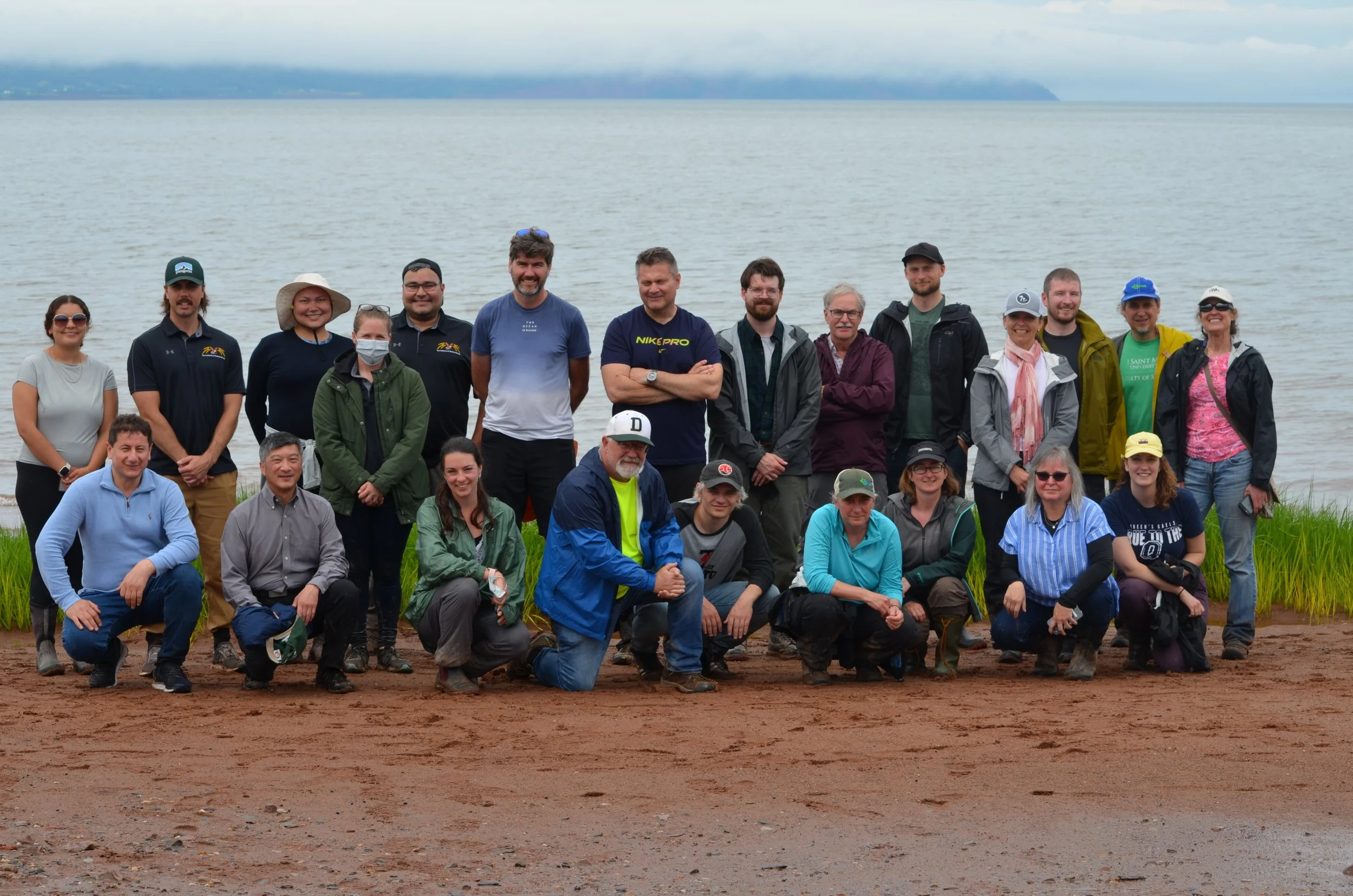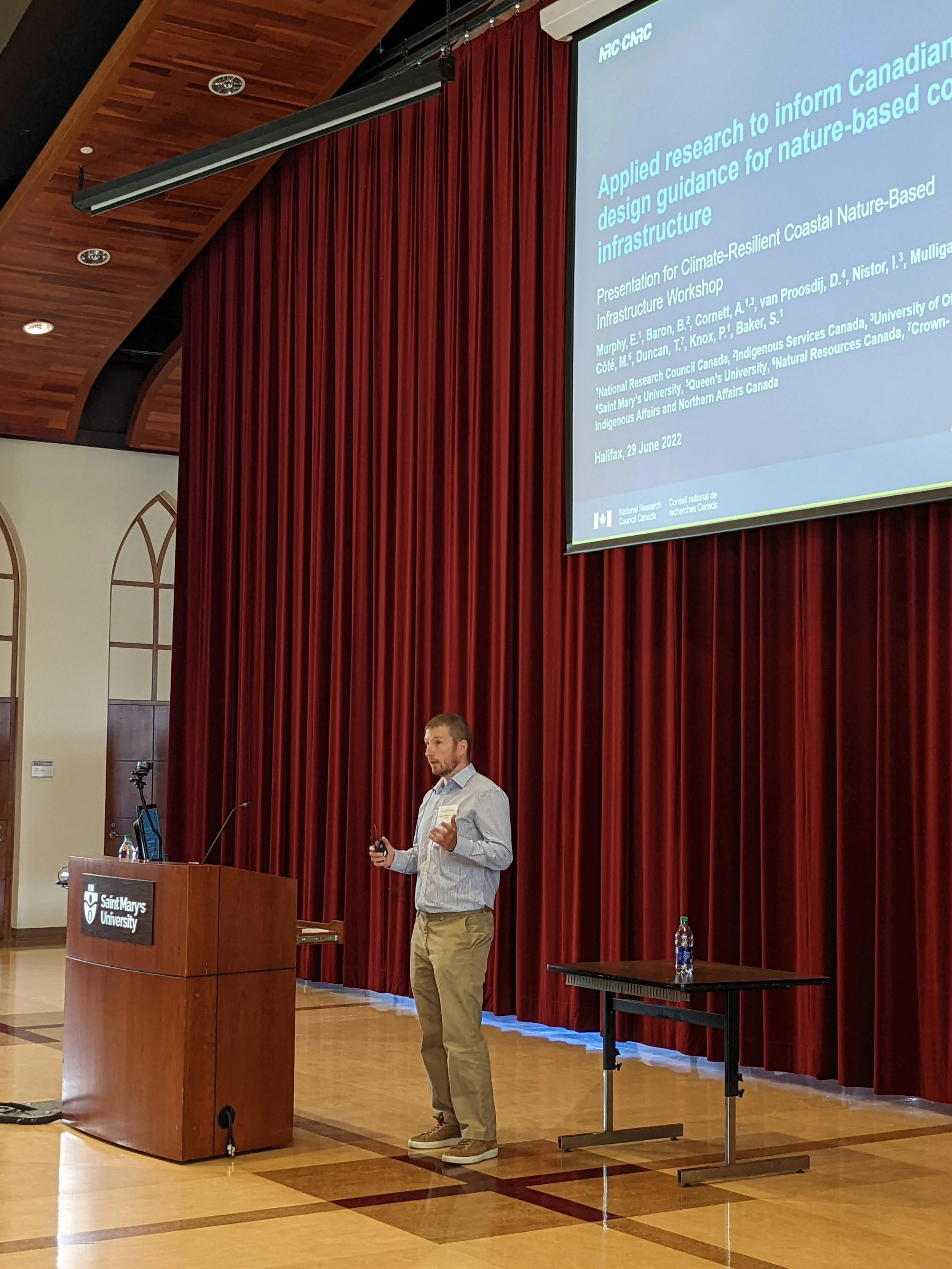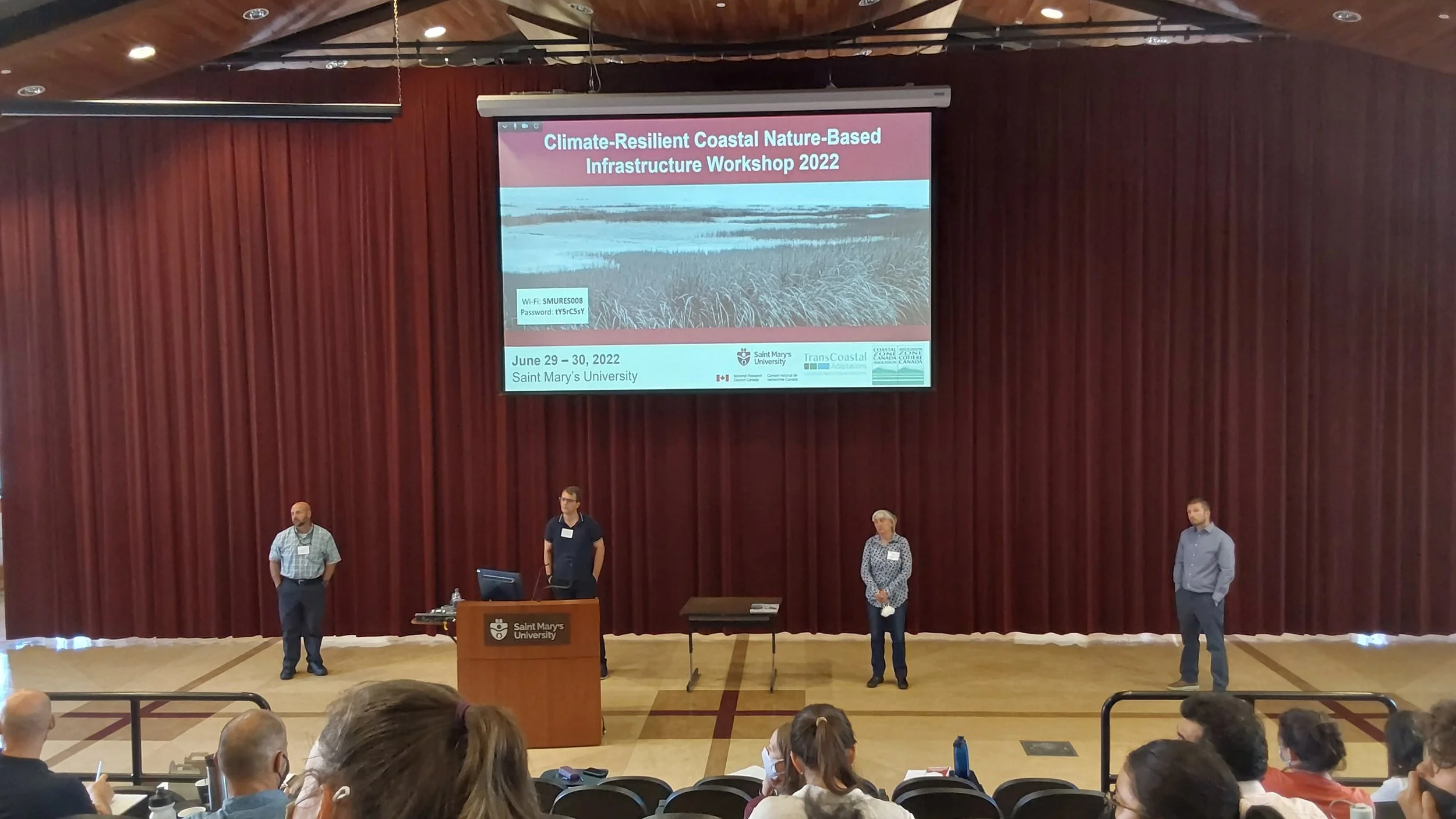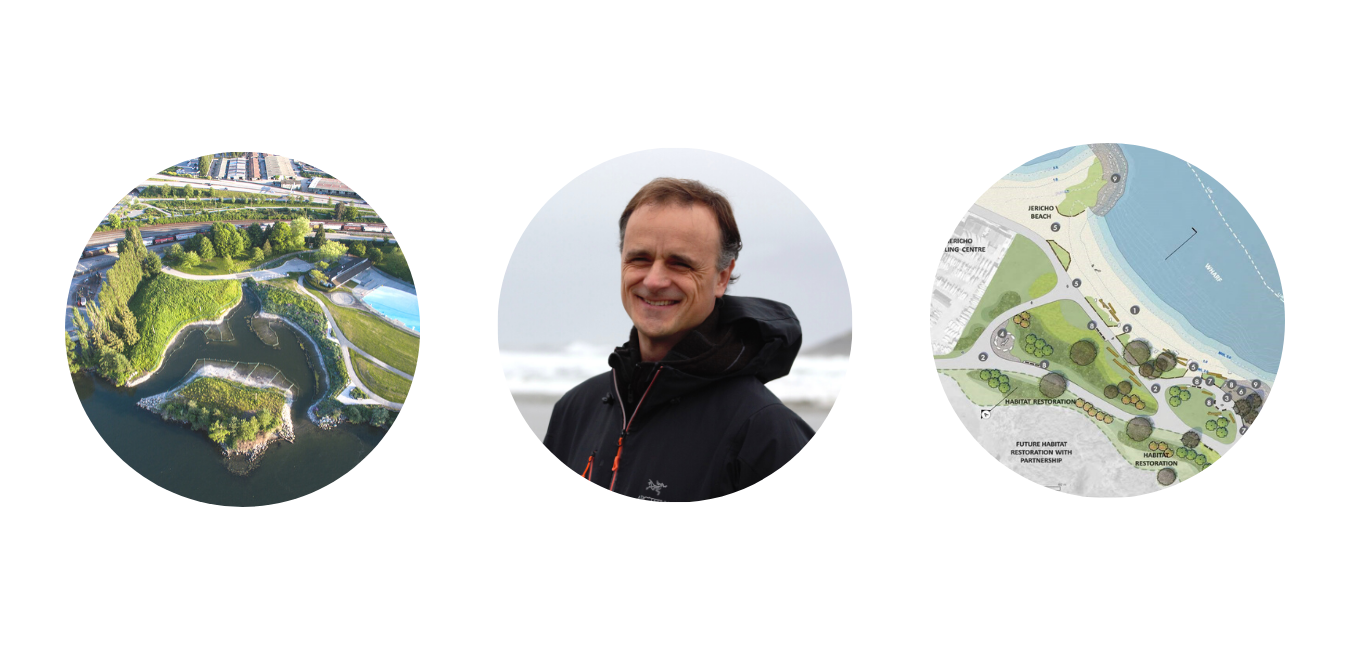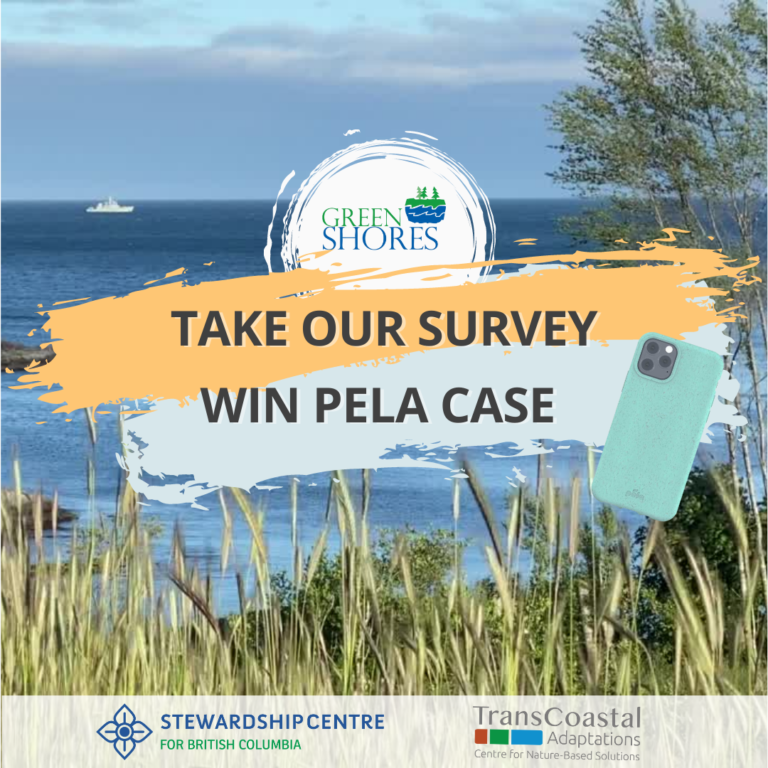On November 28 and 29, SMU and CBWES representatives joined the Confederacy of Mainland Mi’kmaq (CMM), Nova Scotia Department of Agriculture (NSDA), as well as the Department of Communities, Culture, Tourism and Heritage, to direct and support the decommissioning of the dyke. Over the next week, the team completed the decommissioning of the dyke and the removal of the aboiteau, to ultimately support the restoration of a tidal wetland.
How Would A Green Shores® Certified Project Stand Up in a Hurricane?
Green Shores® projects aim to build resiliency for shorelines by restoring natural processes that can be disturbed by human infrastructure and activity. Hard armour infrastructure such as bulkheads reflect wave energy causing the sediment at the base of the structure to be swept away through a process called scouring. This makes the hard armour structure highly vulnerable to collapse or failure. Soft infrastructure is designed to absorb wave energy. For example, planting native vegetation helps dissipate wave energy through friction, allowing for reduced erosion and deposition of sediments on the shore (ANCRIM, 2017). The Green Shores Credits and Ratings systems reward the maintenance of natural shorelines or restoration through removal of hard armouring. By creating a more natural, vegetated shoreline interspersed with organic materials, Green Shores projects also improve habitat quality for important species, such as herons or turtles, while also improving their resilience to hurricanes.
Hurricanes - a threat to Atlantic shorelines and waterfront infrastructure
Hurricanes originate in warm tropical waters, where an area of low air pressure and thunderstorms produces a tropical cyclone that then draws the warm water into the air. The intense winds and rain follow global oceanic currents up the Atlantic coast and are thought to move warm tropical air and water north, distributing that heat to the cooling northern climates. Hurricane force winds typically exceed 117km/hr, and can reach 250km/hr or more (Environment and Climate Change Canada, 2018)!
How to Get Started with Green Shores® for Homes
From predicted sea level rise, to increased strength and frequency of extreme weather events, the effects of climate change are being seen coast to coast. Resulting issues such as flooding and erosion can be damaging to property and concerning to shoreline property owners! While in Nova Scotia, the most common shoreline protections are hard armour solutions such as berms, dykes, and bulkheads (OECD Report, Responding to Rising Seas, 2019), these solutions are often costly, and contribute to coastal squeeze. In contrast to hard armouring solutions, nature-based solutions work to integrate natural shoreline features and restore and protect natural shoreline ecosystems.
If you are a coastal or lakeshore property owner looking to help protect your property and are interested in getting started with the Green Shores for Homes program, keep reading! This article breaks down how to get started on your own Green Shores for Home project and provides links to inspiration projects completed on the West Coast.
Green Shores Photo Contest
Calling all Shoreline Enthusiasts! We are hosting a Canada-wide contest, open to any Canadian who wants to share their shore. Submit a photo of your favourite shoreline to be entered for the chance to win one of 4 MEC e-gift cards! Our favourite photo submissions may also be shared on our social media pages, helping to promote natural shorelines across the nation.
This contest is organized by the Stewardship Centre for British Columbia and TransCoastal Adaptations: Centre for Nature-based Solutions to help spread the word about our continued development and expansion of the Green Shores Program on both the Atlantic and Pacific coasts.
Contest Requirements
We encourage anyone from Canada at least 18 years of age to participate in the contest. The photo must be your own and must be submitted digitally. Contest participants must fill out the form and submit their photo(s) using this link (click to start).
The photo must be of a Canadian shoreline, either along an oceanic coastline, lakeshore, or estuary. Though beautiful and highly valued, riverine systems are not currently covered under the Green Shores program and thus do not meet the criteria for the purposes of this contest. The exception to this is an estuary, which is the boundary between freshwater rivers and the saltwater ocean that often contains brackish water.
Prizes
There will be four e-gift cards to Mountain Equipment Company awarded. Each card is valued at $25 CAD. All participants who meet the submission guideline will be entered for the chance to win 1 of 4 cards. Winners will be selected at random from the submissions. Odds of winning depend on the number of entrants.
More information about the contest can be found on the Terms and Conditions. By taking part in the contest, participants provide their consent to having their photo(s) featured on Stewardship Centre’s and TransCoastal Adaptation’s social media and website pages.
The deadline to enter is December 12, 2022. One submission per individual. Four winners are selected and will be contacted on December 13.
Summer 2022 Newsletter
Coastal Nature-Based Infrastructure Workshop Series 2022
From June 26-30, TransCoastal Adaptations hosted a combined event in collaboration with the National Research Council and Coastal Zone Canada’s Cold Regions Living Shorelines Community of Practice. The Nature-Based Infrastructure for Coastal Resilience and Risk Reduction Symposium and the Climate-Resilient Coastal Nature-Based Infrastructure Workshop connected practitioners, coastal engineers, natural and social scientists, professors, students, planners, politicians, and Indigenous groups. Attendees came from across Canada and the United States to network and share the latest research in coastal and estuarine science.
Nature-Based Infrastructure for Coastal Resilience and Risk Reduction Symposium (June 26–27)
The first event was a two-day symposium for project partners from the Nature-Based Infrastructure for Coastal Resilience and Risk Reduction project. On the first day, project partners met and collaborated on the development of a national engineering guidance document for coastal nature-based infrastructure. This writing workshop was particularly exciting as it was the first time that project partners had formally met in person since the project started in July 2020.
Photo credit: Olga Sadanenko
Field Trip (June 28)
Bridging the Symposium and the Workshop was an exciting opportunity to attend a field trip to a restored salt marsh site. Both Symposium and Workshop participants had the option of going on a guided tour of the Belcher St. Managed Realignment project site, with other stops across the Bay of Fundy landscape including the Avon River Causeway, Port Williams, and Evangeline Beach. TransCoastal Adaptations was joined by the Confederacy of Mainland Mi’kmaq and CB Wetlands and Environmental Specialists Inc. to lead participants in exploring the changing landscapes of the region and to learn about nature-based climate adaptations.
Photo credit: Eric Thurston
Symposium participants; photo credit: Olga Sadaneko
Workshop participants; photo credit: Eric Thurston
Climate-Resilient Coastal Nature-Based Infrastructure Workshop (June 29–30)
The Workshop, hosted by TransCoastal Adaptations and the Cold Regions Living Shorelines Community of Practice, was intended to engage critical discourse around the feasibility of nature-based adaptation to climate change by defining successful cases, developing frameworks, and mobilizing collective lessons learned. The Workshop was open to all interested participants, and it included 32 plenary-style talks attracting leading experts from across Canada and the United States.
Photo credit: Tony Wong
The Workshop was opened by Aaron Prosper from Eskasoni First Nation, who provided a thought-provoking discussion and call for reflection.
The Workshop included plenary talks and two keynote addresses by Jeff King (US Army Corps of Engineers – Engineering with Nature) and Kees Lokman (UBC Coastal Adaptation Lab). It concluded with a panel discussion led by Danker Kolijn (DHI/Coastal Zone Canada Association), Danika van Proosdij (TransCoastal Adaptations), Jeff King (US Army Corps of Engineers), and Enda Murphy (National Research Council/Coastal Zone Canada Association) titled “Where do we go from here as a community?”, which aimed to engage Workshop participants on reflecting on the next steps in building a community of practice and advancing coastal nature-based solutions in Canada.
Photo credit: Tony Wong
Nature-Based Infrastructure Research Expo
The Nature-Based Infrastructure Research Expo on the evening of June 29 showcased nature-based climate adaptation work being conducted regionally, nationally, and internationally. Visitors to the Expo enjoyed networking and learning about organizations and research at the poster booths.
Photo credit: Clare Sully-Stendahl
A big thank you to everyone involved with this event, including all of our wonderful presenters and participants.
Thanks as well to our Workshop Series Co-Chairs (Danika van Proosdij, Danker Kolijn, and Enda Murphy), and our Workshop Organizing Team (Clare Sully-Stendahl, Eric Thurston, and Olga Sadanenko).
Interested in learning more about the research shared at these events? Follow the PDF links below:
Nature-Based Infrastructure for Coastal Resilience and Risk Symposium 2022 Event Program
Climate-Resilient Coastal Nature-Based Infrastructure Workshop 2022 Event Program
Workshop Schedule
Workshop Book of Abstracts
Making Room for Wetlands: In Review
Watch the recording our popular webinar, Making Room for Wetlands: In Review.
This March, TransCoastal Adaptations, in partnership with the Society for Ecological Restoration, hosted a webinar event reviewing the five-year project Making Room for Wetlands: Implementation of Managed Realignment for Salt Marsh Restoration and Climate Change Adaptation in Nova Scotia. This research and restoration work was funded by the Department of Fisheries and Oceans’ Climate Restoration Fund and Nova Scotia Agriculture.
Green Shores Training in the Maritimes: Highlights from 2021
TransCoastal Adaptations has partnered with the Stewardship Centre for British Columbia to bring Green Shores training to the Maritimes.
Green Shores training helps to promote understanding of Green Shores as a framework for nature-based solutions. The training also helps build capacity among both shoreline practitioners and individuals with a general interest in shoreline ecosystem protection.
There are three levels of Green Shores training offered. Level 1 introduces participants to the Green Shores program, including its rationale, benefits, and application. Level 2 offers more in-depth information about how to apply the Green Shores credit and rating systems to shoreline management projects. Level 3 is intended for shoreline practitioners who want to be formally recognized as a Green Shores Approved Professional.
Green Shores Training in the Maritimes: Notes from the Field
In November 2021, 16 people from Nova Scotia and New Brunswick took part in Green Shores Level 1 and 2 training at Saint Mary’s University. The diversity of their career background speaks to the adaptability of the Green Shores program: participants included urban foresters, civil engineers, asset management specialists, students, wetland coordinators at NGOs, and government climate change specialists. The training sessions also served as a networking opportunity between government, academics, NGOs, and industry, which was appreciated by many participants. At least two collaborative project proposals for shoreline design have already been submitted from connections formed during the training sessions.
Over the three days, a little over half the time was spent in the classroom. There, trainees learned about the Green Shores program, got a crash course in geomorphology and coastal erosion, and worked in groups on evaluating public park and home shoreline plans.
The field visits were the highlight of the course for most participants despite the cold, windy, and rainy Maritime November weather. In Level 1 training, participants applied their newly gained skills for the first time at Conrose Park in Halifax in torrential rain, where they worked in groups to plan a Green Shores design to slow heavy erosion at the site.
Level 2 training included an excursion to homes along the Northwest Arm for trainees to create home shoreline designs. Home shoreline design offered a more in-depth approach to Green Shores, since the trainees had to consider existing gardens, docks, boat access, public right of ways, and residential aesthetics in their designs.
The final day’s field excursion took place in Point Pleasant Park where the rough waves called for a greater focus on shoreline processes and how nature-based solutions can attenuate wave action. Point Pleasant Park was an excellent site for the excursion because it has numerous beaches with differing slopes and a variety of rock sizes. The Point Pleasant afternoon concluded with creating a design for a park area that took into consideration erosion, rising sea levels, vegetation, public use, and historical importance.
Are you interested in signing up for Green Shores training?
Visit our Green Shores training webpage to learn more about Green Shores sessions in the Maritimes. For more information about the Green Shores program, visit the Stewardship Centre for BC’s Green Shores website.
Green Shores Testimonials: Who does it benefit?
Green Shores can be used by homeowners, municipalities, professionals, and organizations to create resilient and climate-adaptive shorelines. Folks from homeowners to landscape architects have benefited from Green Shores: Let’s take a look at what they have to say.
Green Shores for Professionals
Professionals working with the shoreline can enrol in Green Shores Training and become Approved Green Shores Professionals. Training adds new knowledge and nature-based techniques to your toolbox that will allow you to make a positive difference for both clients and the environment.
Photo Credit: Left -Stewardship Centre for BC, GSSD, New Brighton Beach Park; Center -Paul de Greef; Right -Stewardship Centre for BC, GSSD, Jericho Beach
“This project means so much to me. I have been working on acceptance of the ideas embodied in the Green Shores program all my working life as a Landscape Architect.” – Victoria Drakeford, Landscape Architect.
“Green Shores affords professionals a critical tool in helping draw awareness to the importance of shoreline stewardship in coastal communities. The program provides a pathway for managing and improving shorelines, especially in the face of accelerating threats from sea level rise. It is an invaluable tool for coastal professionals and coastal communities that are interested in preserving or restoring a wider range of shoreline values.” – Paul de Greeff, Landscape Architect: Green Shores Approved Professional.
Green Shores for Homeowners
The Green Shores for Homes (GSH) program empowers homeowners to make an environmental difference that they can see every day. By certifying your shoreline as a Green Shores project, you get to learn about and protect the shoreline’s local wildlife, water quality, and biodiversity.
Photo Credit: Left -Stewardship Centre for BC, GSH, Piper’s Lagoon; Center -GSH, Fisherman Bay, Washington State; Right -Stewardship Centre for BC, GSH, The Green Point Project
“Becoming involved, reading and learning about the benefits of Green Shores through this project has been enlightening….and fun. Thank you to the Green Shores team for sharing your knowledge and passion for the program. We look forward to enjoying the garden maturing and evolving with the hope of it being an inspiration for neighbouring waterfront owners. Best of all the birds love it!” – Darwin Mahlum, Green Shores for Homes Homeowner at Piper’s Lagoon, Vancouver Island.
“After living in an urban environment for over 20 years, we decided as a family to relocate and live close to nature. Upon moving from Vancouver, British Columbia to Vancouver Island, a chance visit to a historic and beautiful ecosystem in Cowichan Bay, inspired us to make this a live-work place that would eventually become The Green Point Project. “- Kenneth Chooi, Green Shores for Homes Homeowner at Cowichan Bay, Vancouver Island.
Green Shores for Everyone
Anyone from non-profit organizations, universities, real estate developers, and municipalities can make a difference with the Green Shores for Shoreline Development (GSSD) program. Commercial, public, and non-residential shoreline properties such as waterfront development properties and parks are eligible for Green Shores certification through the GSSD program. This provides an opportunity for organizations, local governments, and companies to stand out as environmental leaders and to set a shining example of climate-adaptive environmental stewardship.
Photo Credit: Left -Stewardship Centre for BC, GSCD, Jericho Beach Park, Center -Stewardship Centre for BC, GSCD, Riverbend Business Park, Burnaby, BC.
“We are thrilled that we have been honoured—along with our partners—with this environmental stewardship recognition. The restoration of this beautiful place as an oasis of biodiversity in the urban environment is one of this board’s proudest achievements.” – Vancouver Park Board chair, Stuart Mackinnon.
Green Shores Survey
Take part in our short survey about Green Shores and nature-based solutions for shoreline management! Enter your email at the end to be entered to win a biodegradable Pela phone case.
The survey is organized by the Stewardship Centre for BC and the TransCoastal Adaptations: Centre for Nature-based Solutions.
Summer 2021 Newsletter
Read our Summer newsletter to catch up on TransCoastal Adaptations’ latest project updates, opportunities for students, and more!
Green Shores: Nature-based vs. Hard armoured shorelines
Why use Green Shores?
Green Shores uses nature-based shoreline solutions to protect shoreline property and provide benefits for people, wildlife, and the environment. A Green Shores approach is more cost-effective and resilient to climate change and sea-level rise than hard armouring solutions. Conventional hard armouring such as bulkheads and seawalls disrupt natural shoreline functions, which can worsen erosion and degrade the shoreline.
Read on to learn about the many benefits associated with Green Shores:
Physical processes
Green Shores restores physical processes that promote the natural movement of water and sediment needed to maintain healthy shorelines. Green Shores also protects shorelines from erosion and flooding through soft shore protection, which includes re-sloping, beach nourishment, introducing large woody materials, and planting riparian or intertidal vegetation.
Source: Lake Washington Green Shores for Homes project
Habitat and biodiversity
Green Shores provides more suitable habitat for aquatic and terrestrial insects, plants, birds, fish, and other wildlife, increasing the overall biodiversity of the shoreline. Green Shores incorporates native vegetation that is better adapted to shoreline conditions and does not require irrigation or chemical fertilizers. This vegetation provides food and shelter for native fish and other wildlife, while also preventing erosion.
Source: East Shore Lake Washington Residence, Green Shores for Homes project
Cost-effective
Green Shores and other nature-based, soft shoreline solutions can be 35-70% cheaper to install and maintain than hard alternatives (bulkheads, seawalls) (Green Shores 2020: Impact, Value and Lessons Learned, ESSA). Additionally, Green Shores projects achieve high returns on investment and provide important environmental and societal benefits. For example, analysis suggests that each $1 invested in Green Shores for Shoreline Development (GSSD) program delivery generated $7.10 in social benefit in British Columbia, which is a 1:7 cost-benefit ratio (ESSA).
Source: Piper’s Lagoon, Green Shores for Homes project
Free of contaminants and pollutants
Green Shores prevents and reduces pollutants entering the aquatic environment, resulting in better water quality. Hard armoured structures may introduce toxic compounds and pollutants (such as creosote-treated bulkheads or dock pilings) into aquatic environments. Replacing hard armouring with soft shore approaches such as gravel, logs and vegetation helps to filter water and reduce pollutants entering aquatic environments. Green Shores also improves water quality by reducing run-off from upland through the use of less impervious surfaces.
Source: Jericho Beach Park, Green Shores for Shoreline Development project. Photos by Nick Page, Raincoast Applied Ecology.
Salmon
Green Shores provides spawning habitat for salmon and natural cover for juvenile salmonids using a network of branches, trunks, stems, and roots. Additionally, overhanging vegetation provides important organic input to the aquatic environments that juvenile salmonids feed on. On the other hand, bulkheads, seawalls, and other hard armour approaches do not support fish habitat and instead disrupt food chains and migration paths, contributing to ‘coastal squeeze’ - the serious loss of intertidal habitat.
Natural and Beautiful
Green Shores enhances the natural beauty of shorelines by using native vegetation that thrives in local conditions, providing wildlife viewing opportunities, and providing access to waterfront shorelines and activities.
Source: Hard armour - Riverbend Park - pre-Green Shores for Shoreline Development project. Green Shores design – Jericho Beach Park, Green Shores for Shoreline Development.
Water Quality
Green Shores improves local water quality by reducing stormwater runoff. The native shoreline vegetation encouraged by Green Shores uses an associated network of branches, trunks, stems, and roots to filter upland run-off and enhance infiltration and retention of rainwater.
Source: Green Shores photo by Kelly Loch from Gartley Beach, Comox Valley Regional District in British Columbia.
Consider a nature-based Green Shores approach for your shoreline. Visit our Green Shores Webpage to learn more!
Planned Research in the Chignecto Isthmus
On May 20, partners and stakeholders gathered virtually to present and discuss plans for research taking place in the Chignecto Isthmus to study nature-based infrastructure and its role in mitigating coastal flood and erosion risk in Canada. You can watch our project partners present on this research project with the video to the right.
The Chignecto Isthmus is highly vulnerable to coastal hazards and is one of four study sites selected for the Nature-Based Infrastructure for Coastal Resilience and Risk Reduction project. Research at this site is being led by the National Research Council of Canada in partnership with TransCoastal Adaptations at Saint Mary’s University, Queen’s University, and Natural Resources Canada - Geological Survey of Canada.
Field research and hydrodynamic modelling in Chignecto Bay will take place throughout the Summer, Fall and Winter of 2021. Ultimately, this project will produce a design guidance for coastal infrastructure in Canada, as well as a knowledge base and analytical tools to assess site suitability for nature-based infrastructure.
At the May 20 meeting, stakeholders reported important changes to local dyke infrastructure, and identified a planned marsh restoration project aligned with planned research. The group also discussed the need for updated and accurate bathymetric data of the upper portion of Chignecto Bay. Stakeholders stated support for the research project, and stressed the need to identify solutions to high risk storm surges in the Isthmus.
Data Needed
We are actively searching for current bathymetric data of the Chignecto Bay. If you or your organization has relevant data they would like to share with us for the purposes of this project, please contact Danika Van Proosdij at dvanproo@smu.ca. Likewise, contact us if your organization has interest in funding data collection or if you have information regarding recent dyke breaching or overtopping in the Chignecto Bay area.
Managed Dyke Realignment: Workshops and Knowledge Exchange with European Practitioners and Researchers
This Spring, TransCoastal Adaptations hosted a series of workshops around Managed Dyke Realignment that brought together researchers and practitioners from Europe and North America to share knowledge around managed realignment as a climate risk reduction strategy. Key discussion topics included the wave dissipation potential of marshes, the lowering of dyke heights through the integration of foreshore marsh into dyke design, bio-geomorphic modelling, and the value of long term post-restoration monitoring. Panelists also stressed the need for implementation and monitoring frameworks, and broad government support to facilitate the uptake of managed realignment projects.
These workshops were very successful, with over 120 people registered and over 90 in attendance over three sessions. Presentations were followed by engaging discussion and questions from the audience. Participants represented various sectors, spanning government departments, private industry, not-for-profit organizations, and academia. Video recordings are available below. These workshops were hosted as part of the project Making Room for Wetlands: Implementation of Managed Realignment for Salt Marsh Restoration and Climate Change Adaptation in Nova Scotia.
Session 1: Foreshores for Climate Risk Reduction
Dr. Iris Möller from Trinity College, Dr. Bas Borsje from the University of Twente, and Dr. Vincent Vuik from Delft University of Technology joined us for this session. Speakers presented evidence supporting the development of foreshore marshes as climate-resilient coastal protective measures, and shared cutting-edge research on role of vegetated foreshores in hydraulic engineering. Click here to learn more about the speakers.
Session 2: Managed Dyke Realignment Design
Dr. Jon French from the University College London, Dr. Joshua Kiesel from Kiel University, and Dr. Stijn Temmerman from the University of Antwerp shared their research with us for this session. Here they discuss the use of geo-morphodynamic modelling for tidal marsh design, the hydrodynamic impacts of managed realignment sites, and best design practices. Click here for more information on our speakers.
Session 3: Implementation and Monitoring
Colin Scott from ABPmer, Jonathan Dale from Coventry University, and Jennie Graham from CB Wetlands and Environmental Specialists joined us to discuss the importance of monitoring pre- and post-implementation of managed realignment projects. Speakers shared lessons learned from implementing managed realignment through a practitioner’s lens, and the variables that influence post-restoration tidal marsh morphology. Click here for more information on our speakers.
Introducing Green Shores
TransCoastal Adaptations has partnered with the Stewardship Centre for British Columbia to establish Green Shores® in the Maritimes. Green Shores incentivizes and facilitates natural shoreline habitat creation through a credit and rating system that guides homeowners and developers in the process of adapting shorelines to mitigate erosion, create wildlife habitat, improve water quality, and restore natural sediment processes.
In addition to providing credit and rating guides, Green Shores trains professionals with Green Shores training, who can then help landowners design and certify Green Shores shoreline projects. Local government groups can also facilitate the uptake of Green Shores in communities through the Green Shores for Local Government program.
Keep up to date on Green Shores in the Maritimes through our social media and newsletter!
Student Spotlight: Terrell Roulston
Every week, we’ll aim to spotlight one of our students and their current research topic. To learn more about what Terrell’s working on, visit his profile below.
Student Spotlight: Kayla Williams
Every week, we’ll aim to spotlight one of our students and their current research topic. To learn more about what Kayla’s working on, visit her profile below.




